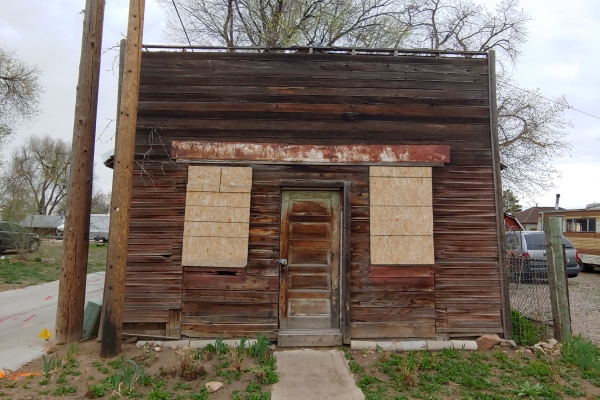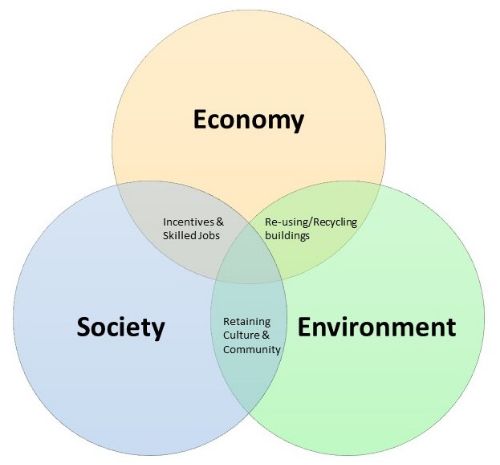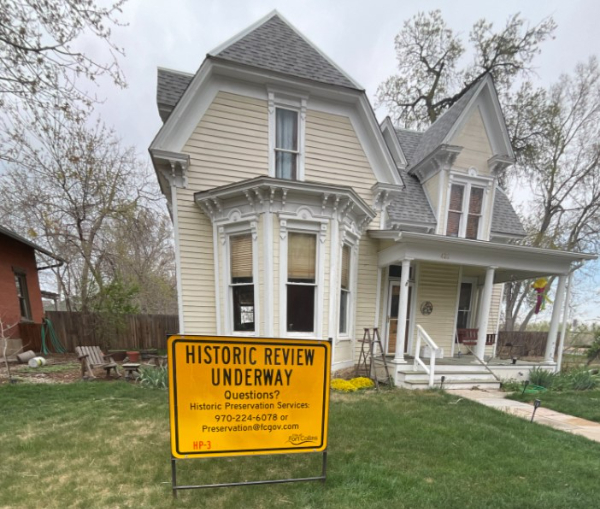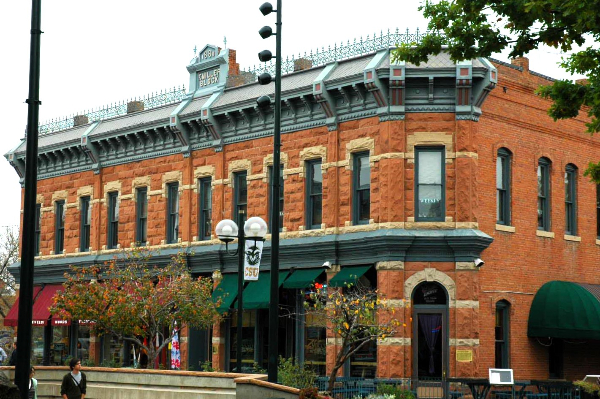Trying to look up if a property is historic?
Check out our online database or explore this map of Fort Collins' historic resources.
Identifying and Labeling Important Historic Places#
The Fort Collins City Code provides certain requirements and opportunities for places in the community (buildings, structures, objects, and sites) that are associated with important stories and people from our local history, our diverse cultural and social groups, and our historic architecture. These places are collectively labeled as “historic resources” in our code. While all of those places tell important stories from our past, only some are protected as Fort Collins Landmarks. These can be either single properties or a collection of properties known as a "Historic District." Places that help tell the story of a historic district are considered "contributing" to that district.
In the United States, historic places can be designated at all levels of government (local, state, or federal). You can learn more about the different levels of historic designation at the links below:
- Fort Collins City Landmarks and Historic Districts
- The Colorado State Register of Historic Places (individual properties and historic districts)
- The National Register of Historic Places (individual properties and historic districts)
- National Historic Landmarks This link opens in a new browser tab- the nation's highest historic designation, indicating significance to national history and excellent integrity to the historic period.
You can also research the history of your property by visiting the Fort Collins History Connection, a collaborative online research tool from the Fort Collins Museum of Discovery and the Poudre River Public Library District.
Quick Reference
Check out this quick reference sheet on the benefits and obligations of owning a historic property in Fort Collins, including code requirements for exterior alterations and financial support programs available!
-
![Historic Store Building at 100 First St.]()
This false-front store, predating 1904, is part of the Maneval/Mason/Sauer Property at 100 First St., which was Landmarked for its architecture, association with the history of Fort Collins's German Russian and Hispanic communities, and more.
A Fort Collins Landmark is a site, building, structure or object officially recognized as important to Fort Collins history by City Council (via an ordinance). That ordinance includes protections for the exterior of the property so that it retains visual connections to its important past. A Landmark can be important for many reasons, including being associated with important history, people, groups, design, types or ways to construct buildings, important cultural associations, or for retaining important archaeological evidence.
-
Nominating your property as a Landmark requires the following steps:
- Complete a Landmark Nomination Form and Character-Defining Features Worksheet to show how the property meets the requirements for Landmark designation (Municipal Code Chapter 14, Article II This link opens in a new browser tab) and sign/notarize the Owner Agreement for Landmark nominations.
- City staff can help you put this nomination together! Please contact preservation@fcgov.com or 970-224-6078 for assistance.
- Submit the completed paperwork to Historic Preservation Services at preservation@fcgov.com or drop off a physical copy at 281 N. College Ave.
- Staff will conduct a historic survey, if needed, to finalize the nomination paperwork, and confirm that the property meets the City’s requirements for Landmark designation.
- If your property is eligible for designation, Staff will work with you to schedule the nomination for review by the Historic Preservation Commission (HPC) at their next available meeting.
- If the HPC agrees that the property is eligible, they will pass a resolution recommending Landmark designation to City Council.
- Staff will schedule the Landmark nomination for review at the next available City Council meeting for final approval via ordinance (completed through two readings over two Council meetings).
- If the Landmark Ordinance is approved by City Council, it will be recorded with the County Clerk and will go into effect ten days after approval.
*For information on the process to initiate a non-owner-supported Landmark nomination, please contact staff at preservation@fcgov.com or 970-224-6078.
-
![Venn diagram showing sustainability's intersection with historic preservation]()
Landmark properties in Fort Collins qualify for several financial support programs, including the City of Fort Collins's 0% interest Landmark Rehab Loans (matching loans for qualifying work up to $7,500 per property per year) and Design Assistance Program mini grants for project planning. The State of Colorado also offers income tax credits for rehab projects (20-30% of qualifying costs back as tax credits). City staff can assist property owners who are planning projects and interested in leveraging these funding sources. You can find more information about all of these programs and others here.
Historic preservation is also inherently sustainable. Preserving historic buildings retains community fabric, helping people feel authentically connected to space and culture. Reinvesting in historic buildings promotes growth in skilled construction trades, provides critical incubation space for small businesses, stabilizes property values, and especially for pre-1950 developments, retains more financially sustainable land use patterns. Reusing historic buildings keeps building materials out of landfills, captures the embodied energy of already constructed buildings, and allows older buildings to continue to harness built-in energy efficiencies.
-
![426 E. Oak St.]()
The Hottel/Hoffman House & Ash Pit at 426 E. Oak St.
Landmark designation requires the review of all exterior alterations, demolition, and new construction under Municipal Code Chapter 14, Article IV. Exterior alterations are reviewed by Staff or the Historic Preservation Commission using a federal set of standards for historic preservation, the Secretary of the Interior's Standards for the Treatment of Historic Properties. Nearly all work fits under the Standards for Rehabilitation, which is defined as “the act or process of making possible a compatible use for a property through repair, alterations, and additions while preserving those portions or features which convey its historical, cultural, or architectural values.”
Interior work does not undergo historic preservation review from the City of Fort Collins. However, both interior and exterior work will be reviewed by the State Historic Preservation Office (History Colorado) if an owner is seeking State Historic Tax Credits for a project that includes interior work.
Landmark designation does not change the allowed uses of your property, which are established by its zoning district, and designation also does not require restoration of missing historic elements. There are minimum maintenance requirements required by code; see Municipal Code Sec. 14-7 for more information.
Are you planning a project for exterior alterations or repairs to your historic property? Contact Historic Preservation Services staff about Landmark Design Review for technical and process guidance at preservation@fcgov.com or 970-224-6078.
-
![Miller Block at 11 Old Town Square]()
Miller Block, 11 Old Town Square
Yes! There are 3 other types of historic designations:
State Register: The Colorado State Register of Historic Properties is a listing of the state's significant cultural resources worthy of preservation for the future education and enjoyment of Colorado's residents and visitors. The Colorado State Register program is administered by History Colorado, the State Historic Preservation Office. History Colorado maintains an official list of all properties included in the Colorado State Register. Click here for a list of Fort Collins properties listed in the State Register.
National Register: The National Park Service administers the National Register of Historic Places. The National Register is the federal government’s official list of districts, sites, buildings, structures, and objects significant in American history, architecture, archaeology, engineering, and culture. While designation in the National Register is honorary only, it does qualify those properties for certain federal financial incentives. Click here for a list of properties in Fort Collins listed in the National Register and here to learn more about the Old Town and Laurel School Historic Districts on the National Register of Historic Places.
National Historic Landmarks: National Historic Landmarks (NHLs) are nationally significant historic places designated by the Secretary of the Interior because they possess exceptional value or quality in illustrating or interpreting the heritage of the United States. Today, just over 2,500 historic places bear this national distinction. Working with citizens throughout the nation, the National Historic Landmarks Program draws upon the expertise of National Park Service staff who guide the nomination process for new Landmarks and provide assistance to existing Landmarks. Fort Collins only has one NHL in its area - the Lindenmeier Archaeological site north of the city. Learn more about NHLs here.



